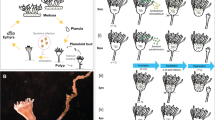Abstract
The fresh water polyp Hydra is noted for its ability to regenerate missing body parts. Transplantation experiments indicate that the control of regeneration includes signalling over long distances. These signals appear to include diffusible morphogens, activators and inhibitors. In order to elucidate the nature of such signals, tissue of polyps was homogenized and fractionated. The fractions were tested for their ability to hinder head regeneration. The active factor within these fractions was determined to be methionine. Both the active fractions and L-methionine were found to antagonize not only head regeneration but also foot regeneration. Budding, the asexual means of reproduction, is antagonized. L-methionine acts in micromolar concentrations while the stereoisomer D-methionine does not. L-methionine may act by providing a methyl group in transmethylation processes.
Similar content being viewed by others
References
Gierer A., Meinhardt H., A theory of biological pattern formation, Kybernetik, 1972, 12, 30–39
Schaller H.C., Schmidt T., Grimmelikhuijzen C.J.P., Separation and specificity of action of four morphogenes from Hydra, Roux’s Arch. Dev. Biol., 1979, 186, 139–149
Sinha S.N.V., Joshi J., Rao S., Mookerjee S., A 4 variable model for the pattern forming mechanism in Hydra, Biosystems, 1984, 17, 15–22
Meinhardt H., A model of biological pattern formation of hypostome, tentacles and foot in Hydra: How to form structures close to each other, how to form them at a distance, Dev. Biol., 1993, 157, 321–333
Wolpert L., Positional information and the spatial pattern of cellular differentiation, J. Theor. Biol., 1969, 25, 1–47
Berking S., Hydrozoa metamorphosis and pattern formation, Curr. Top. Dev. Biol., 1998, 38, 81–131
Müller W.A., Plickert G., Berking S., Regeneration in Hydrozoa: distal versus proximal transformation in Hydractinia, Roux’s Arch. Dev. Biol., 1986, 195, 513–518
Plickert G., Low-molecular-weight factors from colonial hydroids affect pattern formation, Roux’s Arch. Dev. Biol., 1987, 196, 248–256
Tripp K., Die Regenerationsfähigkeit von Hydren in den verschiedenen Körperregionen. Nach Regenerations- und Transplantationsversuchen, Z. Wiss. Zool., 1928, 132, 476–525, (in German)
Berking S., A model for budding in Hydra: pattern formation in concentric rings, J. Theor. Biol., 2003, 222, 37–52
Lenhoff H.M., Culturing large numbers of Hydra, In: Lenhoff H.M., (Ed.), Hydra: research methods, Plenum Press, New York, London, 1983, 53–62
Berking S., Bud formation in Hydra: Inhibition by an endogenous morphogen, Roux’s Arch. Dev. Biol., 1977,181, 215–225
Berking S., Analysis of head and foot formation in Hydra by means of an endogenous inhibitor, Roux’s Arch. Dev. Biol., 1979,186, 189–210
Berking S., The fractionation of a Hydra-derived inhibitor into head and foot inhibitors may be an artefact, Roux’s Arch. Dev. Biol., 1983,192, 327–332
Schaller C., The head and the foot inhibitors are not Dowex artefacts, Roux’s Arch. Dev. Biol., 1984, 193, 117–118
Joseph M.H., Marsden C.A., Aminoacids and small peptides, In: Lim C.K., (Ed.), H.p.l.c. of small molecules: a practical approach, IRL Press, Oxford, England, UK, 1986
Epp L.G., Tardent P., Bänninger R., Isolation and observation of tissue layers in Hydra Attenuata Pall., Trans. Amer. Micros. Soc., 1979, 98, 392–400
Bode H.R., Heimfeld S., Chow M.A., Huang L.W., Gland cells arise by differentiation from interstitial cells in Hydra attenuate, Dev. Biol., 1987, 122, 577–585
Gierer A., Berking S., Bode H., Flick K., David C.N., Hansmann G., et al., Regeneration of Hydra from reaggregated cells, Nature, New Biol., 1972, 239, 98–101
Zeretzke S., Berking S., In the multiheaded strain mh-1 of Hydra magnipapillata the ectodermal epithelial cells are re sponsible for the formation of additional heads and the endoder mal epithelial cells for the reduced ability to regenerate a foot, Develop. Growth Differ., 2002, 44, 85–93
Villar-Garea A., Fraga M.F., Espada J., Esteller M., Procaine is a DNA-demethylating agent with growth-inhibitory effect in human cancer cells, Cancer Research, 2003, 63, 4984–4989
Müller W.A., Competition for factors and cellular resources as a principle of pattern formation in Hydra II. Assistance of foot formation by heads and buds and a new model of pattern control, Dev. Biol., 1995, 167, 175–189
Tardent P., Experimente zum Knospenbildungsprozess von Hydra attenuata (PALL.), Rev. suisse. Zool., 1972, 79, 355–375, (in German)
Pérez F., Berking S., Protein kinase modulators interfere with bud formation in Hydra vulgaris, Roux’s Arch. Dev. Biol., 1994, 203, 284–289
Sanyal S., Bud determination in Hydra, Indian J. Exp. Biol., 1966, 4, 88–92
Campbell R.D., Elimination of Hydra interstitial and nerve cells by means of colchicines, J. Cell Sci., 1976, 21, 1–13
Berking S., Transmethylation and control of pattern formation in Hydrozoa, Differentiation, 1986, 32, 10–16
Zeretzke S., Pérez F., Velden K., Berking S., Ca2+-ions and pattern control in Hydra, Int. J. Dev. Biol. 2002, 46, 705–710
Hobmayer B., Rentzsch F., Kuhn K., Happel C.M., Cramer von Laue C., Snyder P., et al., WNT signalling molecules act in axis formation in the diploblastic metazoan Hydra, Nature 2000, 407, 186–189
Author information
Authors and Affiliations
Corresponding author
About this article
Cite this article
Berking, S., Hoffmann, U., Schäfer, M. et al. Methionine in pattern control of Hydra . cent.eur.j.biol. 4, 549–557 (2009). https://doi.org/10.2478/s11535-009-0038-9
Received:
Accepted:
Published:
Issue Date:
DOI: https://doi.org/10.2478/s11535-009-0038-9




